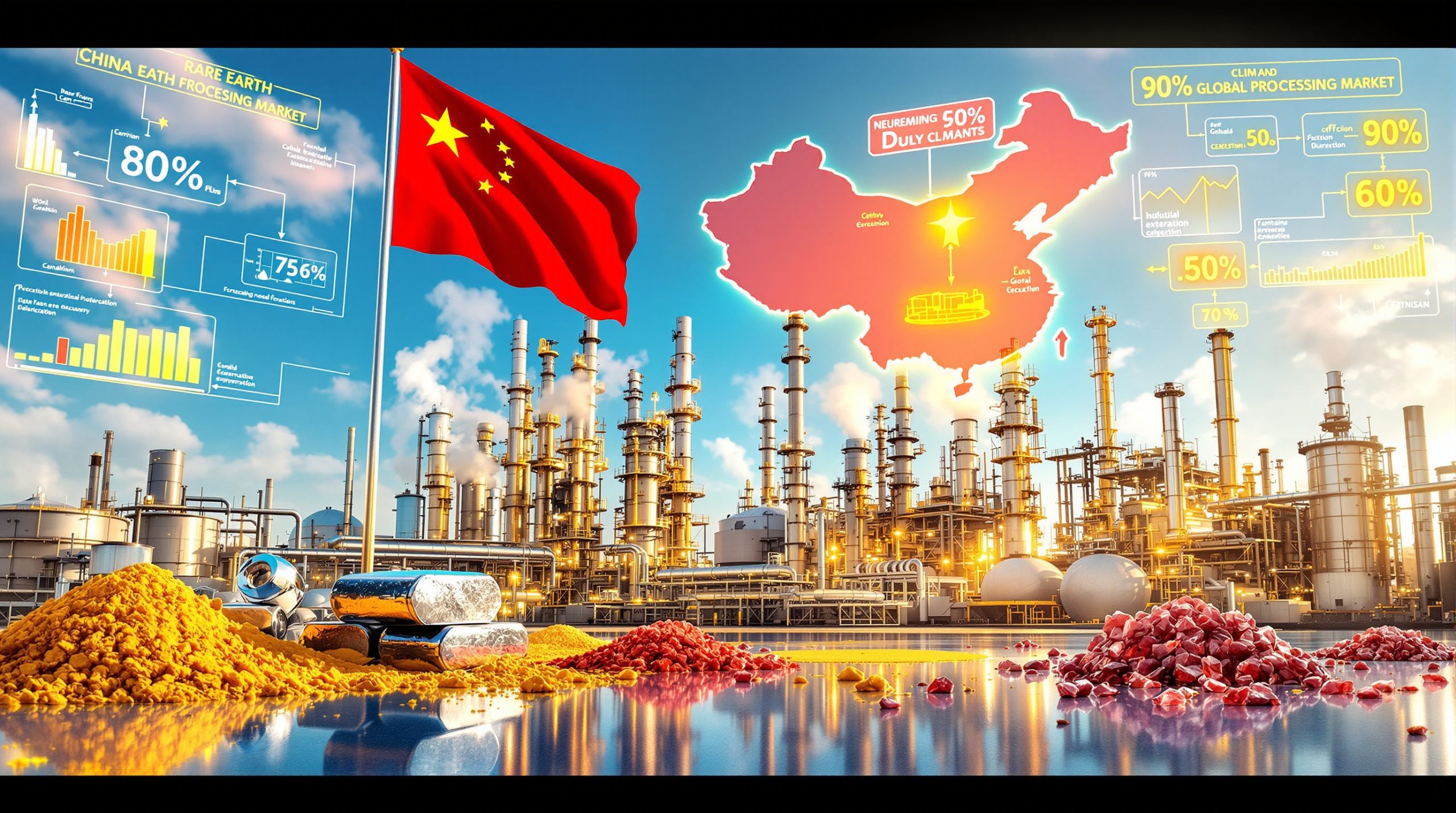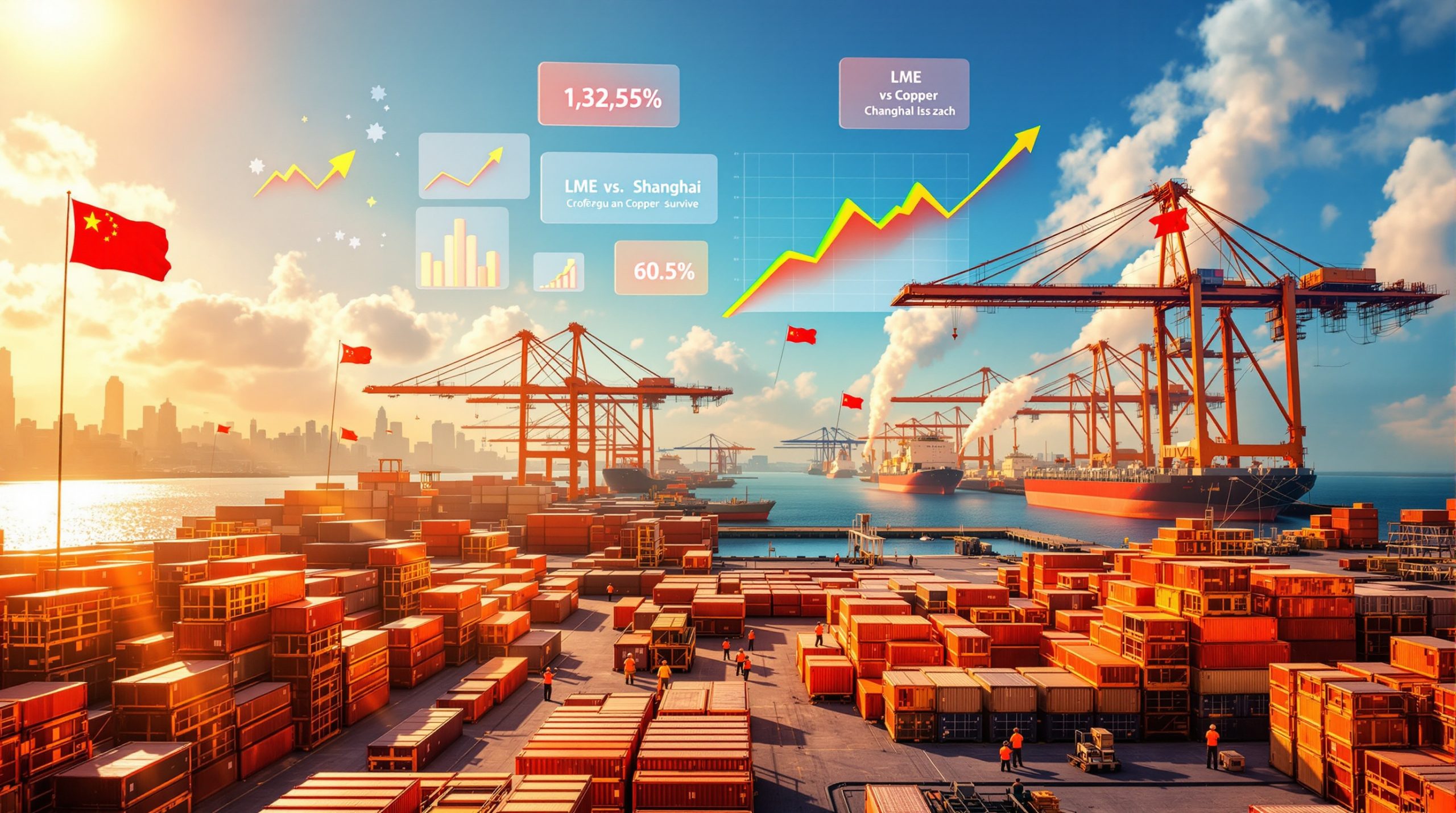China's rare earth processing monopoly represents one of the most significant strategic vulnerabilities facing the global technology sector today. While much attention focuses on mining operations, the true chokepoint lies in China's overwhelming control over the refining and processing infrastructure that transforms raw rare earth ores into the materials essential for modern electronics, defense systems, and clean energy technologies. Furthermore, the critical minerals energy transition highlights how this dependency affects global sustainability goals.
What Makes China's Rare Earth Processing Dominance So Complete?
The Scale of Chinese Control Across the Supply Chain
China's dominance extends far beyond simple mining operations, creating a multi-layered strategic advantage that proves extremely difficult to challenge. According to Morgan Stanley's comprehensive analysis, China controls approximately 65% of global mined rare earth supply and a staggering 88% of refined rare earth supply. This processing monopoly represents the critical bottleneck in global supply chains.
The scale of this control becomes even more apparent when examining magnet production, where Chinese facilities dominate over 90% of global output. This vertical integration from ore extraction through finished magnet manufacturing creates multiple dependency points that Western nations struggle to replicate.
| Supply Chain Stage | China's Market Share | Global Impact |
|---|---|---|
| Raw ore mining | 65% | Moderate vulnerability |
| Refined processing | 88% | Critical dependency |
| Magnet production | >90% | Severe bottleneck |
Beyond Raw Materials: Technology and Expertise Monopolization
China's rare earth processing monopoly extends beyond infrastructure into technological expertise and institutional knowledge. Decades of concentrated investment have created specialized processing capabilities that Western nations cannot quickly duplicate.
The country has systematically restricted exports of processing equipment and manufacturing technology while limiting the transfer of technical expertise abroad. These barriers prevent knowledge transfer and maintain China's technological advantages in rare earth refining processes.
Chinese processing facilities have also achieved economies of scale that make competing operations economically challenging. The integration of environmental cost externalization with advanced processing technology creates cost advantages that Western competitors struggle to match while maintaining environmental standards.
Why Are Rare Earth Elements Critical for Modern Technology?
Essential Applications Driving Global Demand
Rare earth elements serve as the foundation for technologies that define modern civilization. Defense systems rely heavily on these materials for precision-guided weapons, advanced radar systems, and naval propulsion technologies where substitution remains technically impossible. However, the defence critical minerals supply situation continues to create strategic vulnerabilities.
Consumer electronics represent another critical application area:
- Smartphone components requiring miniaturized high-performance magnets
- Electric vehicle motors demanding maximum efficiency and power density
- Wind turbine generators needing reliable operation in harsh conditions
- Advanced computing systems for artificial intelligence and quantum applications
The emergence of humanoid robotics adds a new dimension to demand projections. Each humanoid robot requires approximately 0.9 kg of neodymium-praseodymium (NdPr), along with significant quantities of other critical materials including 180g of cobalt and 1.4kg of nickel.
The Unique Properties That Make Substitution Difficult
Rare earth elements possess magnetic and electronic properties that current alternative materials cannot replicate. Neodymium-iron-boron (NdFeB) magnets provide magnetic strength and temperature resistance essential for aerospace applications and high-performance electric motors.
The miniaturization demands of advanced electronics require rare earth elements' unique combination of magnetic strength and compact form factors. Alternative materials like ferrite magnets lack the power density needed for modern applications, while electromagnetic systems prove too bulky for portable devices.
Temperature resistance represents another critical factor. Rare earth magnets maintain their magnetic properties across extreme temperature ranges, making them irreplaceable for military applications and aerospace systems where component failure could prove catastrophic.
How Did China Achieve This Strategic Advantage?
The Historical Foundation (1990s-2010s)
China's path to rare earth processing dominance began with strategic decisions made during the 1990s and 2000s. The country accepted environmental costs that Western nations were unwilling to bear, allowing Chinese processors to offer significantly lower production costs.
Massive state investment in processing infrastructure created facilities capable of handling the complex separation and purification processes required for rare earth refining. These investments occurred while Western countries allowed their domestic processing capabilities to decline due to environmental concerns and economic pressures.
Strategic acquisition of international mining assets and processing technology accelerated China's learning curve. Chinese companies systematically acquired Western rare earth expertise through joint ventures, technology transfers, and direct acquisitions of foreign operations.
Modern Consolidation Tactics
Today's Chinese rare earth industry reflects deliberate consolidation under state control. Vertical integration from mining through finished magnet production ensures Chinese companies capture value at every stage while maintaining supply chain security.
The creation of state-controlled rare earth conglomerates has standardized production practices and coordinated global market strategies. These entities operate with government backing and long-term strategic objectives rather than purely commercial considerations.
Production quotas and export licensing systems provide additional control mechanisms. China can influence global prices and availability through administrative decisions, creating leverage over international customers and competitors.
What Are the Real-World Consequences of This Monopoly?
Supply Chain Vulnerabilities Exposed
The 2010 rare earth export restrictions demonstrated the fragility of global supply chains dependent on Chinese processing. Price spikes and manufacturing delays affected industries worldwide, from automotive production to consumer electronics.
Manufacturing sectors discovered they had no viable alternatives when Chinese supply became constrained. Even companies with diversified sourcing strategies found themselves dependent on Chinese processing facilities for refined materials.
Defense procurement systems faced particular challenges, as military contractors realised their supply chains depended on a potential adversary for critical components. This vulnerability extends to precision munitions, stealth technology, and advanced naval systems.
Economic Leverage in International Relations
China's rare earth processing monopoly provides significant diplomatic leverage during international negotiations. Access to refined rare earths can influence technology transfer discussions and trade negotiations with Western partners.
The threat of supply restrictions affects long-term planning across multiple industries. Companies must consider geopolitical risks when designing products and planning production facilities that depend on rare earth inputs.
Green energy transition timelines become subject to Chinese policy decisions regarding rare earth availability. Wind turbine and electric vehicle production schedules depend ultimately on Chinese processing capacity and export policies.
Which Industries Face the Greatest Risk from Chinese Control?
Electric Vehicle Manufacturing
Electric vehicle production faces severe vulnerability to China's rare earth processing monopoly. High-efficiency electric motors require NdPr magnets that Chinese facilities predominantly supply. Manufacturing disruptions could significantly impact EV production scaling and climate transition objectives.
According to Morgan Stanley's analysis, global demand projections show potential NdPr deficits of 13-26% by 2040-2050. These shortfalls become more severe when considering humanoid robotics adoption, which could increase global NdPr demand by 167% by 2050 relative to 2030 baselines.
Cost implications extend beyond material availability to pricing volatility. Supply constraints could drive rare earth magnet prices significantly higher, affecting EV affordability and adoption rates across global markets.
Renewable Energy Infrastructure
Wind turbine generators depend entirely on rare earth magnets for efficient power generation. Large offshore wind installations require substantial quantities of NdPr magnets that Chinese processing facilities supply almost exclusively.
Solar panel manufacturing faces different but related dependencies on Chinese processing capabilities. While less direct than wind turbines, solar technology supply chains connect to Chinese rare earth processing through component manufacturing.
Grid storage technologies increasingly rely on advanced materials that require rare earth processing. Energy storage systems critical for renewable energy integration could face constraints tied to Chinese supply chain decisions.
Advanced Defense Systems
Military applications present the most sensitive vulnerabilities to China's rare earth processing monopoly. Critical defense systems cannot function without rare earth magnets, creating dependency on a strategic competitor for essential military capabilities.
Specific military applications include:
- Precision-guided munitions requiring accurate targeting systems
- Stealth technology depending on specialised material properties
- Naval propulsion systems using high-performance electric motors
- Aerospace applications demanding extreme temperature tolerance
These dependencies affect long-term defence procurement strategies and military readiness planning across Western nations.
How Are Western Nations Responding to This Challenge?
Alternative Supply Chain Development Efforts
Western nations have initiated multiple projects aimed at reducing dependence on Chinese rare earth processing. The australia critical minerals reserve represents the most advanced non-Chinese processing developments, with several projects advancing toward production.
U.S. Defense Production Act funding targets domestic processing capability development. These initiatives aim to create secure supply chains for defence applications whilst building commercial processing capacity.
Canadian and European Union strategic partnerships focus on integrated North American and European supply chains. These collaborations attempt to combine Canadian mining capabilities with European processing expertise and American market demand.
The Reality of Development Timelines
The average 17.8-year timeline for new mining projects represents the fundamental constraint on Western diversification efforts. This figure, based on 2020-2024 industry data, illustrates why rapid supply chain diversification proves practically impossible.
Processing facility construction and commissioning adds additional years to project timelines. Even well-funded initiatives face technical challenges, permitting delays, and workforce development requirements that extend deployment schedules.
Workforce development presents a particularly difficult challenge. Rare earth processing requires specialised technical expertise that currently concentrates in Chinese facilities. Training new engineers and technicians takes years, even with accelerated programmes.
Recycling and Circular Economy Initiatives
Electronic waste recovery represents one potential source of rare earth materials outside Chinese control. Programmes targeting smartphone, computer, and automotive component recycling could provide supplemental supply sources.
Magnet remanufacturing and refurbishment technologies offer pathways to extend rare earth magnet lifecycles. These approaches could reduce new material demand whilst maintaining performance requirements.
Consequently, urban mining initiatives attempt to recover rare earths from existing infrastructure and waste streams. However, current recovery rates remain low, and economic viability depends on significantly higher rare earth prices.
What Does the Future Hold for Rare Earth Processing?
Demand Projections Through 2050
Morgan Stanley's comprehensive demand analysis reveals sobering projections for critical material availability. Multiple materials face severe deficit projections that could reshape global technology development:
| Material | Projected Deficit | Timeline |
|---|---|---|
| NdPr | 13-26% | 2040-2050 |
| Lithium | 75-78% | 2040-2050 |
| Cobalt | 16-34% | 2040-2050 |
| Nickel | 17-25% | 2040-2050 |
Humanoid robotics development significantly amplifies these projections. Each humanoid robot requiring 0.9kg of NdPr means widespread adoption could fundamentally alter global rare earth demand patterns.
Demand growth projections show humanoid adoption increasing NdPr requirements by 40% by 2040, 110% by 2045, and 167% by 2050 compared to 2030 baseline consumption levels.
Technological Disruption Possibilities
Alternative magnet technologies under development could potentially reduce rare earth dependencies. Research into new magnetic materials explores compositions that might achieve similar performance without rare earth elements.
Substitution research focuses on specific applications where alternative materials might prove viable. However, current substitute materials cannot match rare earth magnet performance across the full range of demanding applications.
Efficiency improvements offer another pathway for reducing material intensity. Advanced motor designs and manufacturing processes could deliver equivalent performance using fewer rare earth materials per unit.
Geopolitical Scenarios and Their Implications
Expanded Chinese export restrictions represent a significant risk scenario for global technology industries. More severe limitations could trigger supply crises across multiple sectors simultaneously, as the geopolitical metals landscape continues to evolve.
Western alliance coordination on supply security attempts to create alternative procurement systems. However, the scale and timeline challenges make rapid progress unlikely without dramatic policy interventions.
Technology decoupling effects could reshape rare earth markets if Western nations successfully develop independent supply chains. Such decoupling would likely result in higher costs but greater supply security for participating countries.
Investment and Business Implications of Chinese Dominance
Opportunities in Alternative Supply Chains
Non-Chinese rare earth companies with development projects represent potential investment opportunities as diversification efforts accelerate. These companies benefit from strategic value beyond purely economic considerations.
Processing technology developers and equipment manufacturers could capture value from Western supply chain development initiatives. Specialised equipment for rare earth separation and purification faces growing demand outside China.
Recycling and urban mining investment themes align with circular economy trends whilst addressing supply security concerns. Companies developing efficient rare earth recovery technologies could benefit from both environmental and strategic drivers.
Risk Management for Technology Companies
Supply chain diversification strategies require long-term planning and significant capital investment. Companies cannot quickly pivot away from Chinese suppliers without accepting higher costs and potential quality compromises.
Strategic inventory management approaches attempt to buffer against supply disruptions. However, rare earth material degradation and capital costs limit the effectiveness of stockpiling strategies.
Alternative material research and development priorities focus on reducing rare earth dependencies through technological innovation. These investments may provide competitive advantages if successful substitutes emerge.
Key Takeaways: The Strategic Reality of Rare Earth Dependence
The Structural Nature of Chinese Advantage
Decades of concentrated investment have created cost advantages that competing nations cannot quickly overcome. China's environmental cost externalisation, combined with massive scale economies, establishes a structural competitive position.
Integrated supply chains from mining through finished products provide multiple advantages. Chinese companies control costs, quality, and delivery timing across the entire value chain, creating customer dependencies that extend beyond simple price competition.
Technical expertise concentrated in Chinese institutions represents a knowledge monopoly that requires years or decades to replicate. The combination of specialised equipment, experienced personnel, and institutional knowledge creates barriers to entry that pure capital investment cannot overcome.
Long-Term Implications for Global Technology
Continued Chinese leverage over advanced manufacturing will shape technology development patterns for decades. Product designs, manufacturing locations, and innovation priorities must account for rare earth supply constraints and geopolitical risks.
Constraints on Western technological independence affect national security planning and economic strategy. Dependence on China's rare earth processing monopoly creates vulnerabilities that extend far beyond commercial considerations.
The need for fundamental rethinking of critical material strategies becomes increasingly urgent as demand growth accelerates. Current approaches prove insufficient for the scale and timeline of emerging challenges.
Disclaimer: This analysis incorporates forward-looking projections and strategic assessments that involve inherent uncertainties. Material demand forecasts, geopolitical scenarios, and technology development timelines represent informed estimates rather than guaranteed outcomes. Investment decisions should consider multiple perspectives and professional financial advice. The rare earth processing industry involves complex technical, environmental, and regulatory factors that could significantly affect actual developments compared to current projections.
Looking to Navigate Critical Minerals Investment Opportunities?
Discover how major mineral discoveries can unlock significant market returns by exploring Discovery Alert's dedicated discoveries page, powered by the proprietary Discovery IQ model. Stay ahead of critical minerals opportunities with instant alerts on significant ASX discoveries, transforming complex geological data into actionable investment insights before the broader market reacts.




